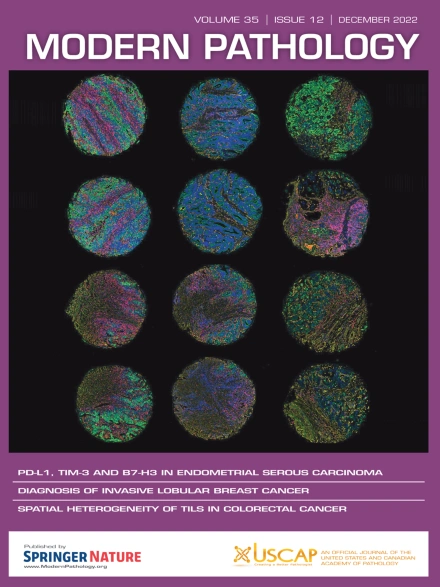Spatial Transcriptomics Reveals Cancer and Stromal Cell Heterogeneity Between Center and Invasive Front of Pancreatic Cancer
IF 7.1
1区 医学
Q1 PATHOLOGY
引用次数: 0
Abstract
Intratumor heterogeneity is considered a major cause of treatment failure in pancreatic ductal adenocarcinoma (PDAC). In recent years, marked heterogeneity at the genomic and transcriptional level has been revealed, but the spatial distribution of the heterogeneous cell populations has not been considered. Yet, it is assumed that cancer cells at the invasive front are endowed with enhanced migratory and invasive properties, although evidence is scanty, and cancer-associated fibroblasts (CAFs) in this location have not been characterized. In this study, digital spatial profiling was used to compare the transcriptional profiles of cancer cells and CAFs in the tumor center versus the invasive front of human PDAC. Four well-differentiated PDACs with conventional morphology were investigated with the GeoMx system (Nanostring). Regions of interest were analyzed in the tumor center and at the invasive front using a whole transcriptome assay in the cancer cell and CAF segments separately. Three of the PDACs harbored mutated KRAS, whereas the fourth case was confirmed wild-type KRAS. Substantial inter-regional heterogeneity was identified, with increased activity of pathways associated with cellular stress (including TNFα-signaling via NFκB, hypoxia, P53 pathway), proliferation (MYC targets, mitotic spindle), glycolysis, and epithelial–mesenchymal transition (EMT) at the invasive front in both the cancer cell and CAF segments compared with the center of the tumor. Immunohistochemical validation on 17 PDACs of well, moderate, and poor differentiation confirmed significant inter-regional heterogeneity in the expression level of markers of EMT and glycolysis. The results of this study show that in PDAC, transcriptional profiles of both cancer cells and CAFs differ between the center of the tumor and the invasive front.
空间转录组学揭示胰腺癌中心和浸润前癌间质细胞异质性。
肿瘤内异质性被认为是胰腺导管腺癌(PDAC)治疗失败的主要原因。近年来,在基因组和转录水平上发现了明显的异质性,但异质性细胞群体的空间分布尚未得到考虑。然而,尽管证据不足,并且该位置的癌症相关成纤维细胞(CAFs)尚未被表征,但假设侵袭前沿的癌细胞具有增强的迁移和侵袭特性。在这项研究中,使用数字空间谱来比较肿瘤中心的癌细胞和cas与人类PDAC侵袭前的转录谱。利用GeoMx系统(Nanostring)研究了四种具有常规形态的分化良好的pdac。在肿瘤中心和侵袭前沿分别使用癌细胞和CAF片段的全转录组分析感兴趣的区域。其中3例pdac携带突变KRAS,而第4例确诊为野生型KRAS。发现了大量的区域间异质性,与肿瘤中心相比,癌细胞和CAF段侵袭前与细胞应激(包括通过NFκB、缺氧、P53通路的tnf α-信号传导)、增殖(MYC靶点、有丝分裂纺锤体)、糖酵解和上皮-间质转化相关的通路活性增加。对17例分化良好、中度和低分化的pdac进行免疫组化验证,证实EMT和糖酵解标志物的表达水平存在显著的区域间异质性。本研究结果表明,在PDAC中,癌细胞和CAFs的转录谱在肿瘤中心和浸润前部之间存在差异。
本文章由计算机程序翻译,如有差异,请以英文原文为准。
求助全文
约1分钟内获得全文
求助全文
来源期刊

Modern Pathology
医学-病理学
CiteScore
14.30
自引率
2.70%
发文量
174
审稿时长
18 days
期刊介绍:
Modern Pathology, an international journal under the ownership of The United States & Canadian Academy of Pathology (USCAP), serves as an authoritative platform for publishing top-tier clinical and translational research studies in pathology.
Original manuscripts are the primary focus of Modern Pathology, complemented by impactful editorials, reviews, and practice guidelines covering all facets of precision diagnostics in human pathology. The journal's scope includes advancements in molecular diagnostics and genomic classifications of diseases, breakthroughs in immune-oncology, computational science, applied bioinformatics, and digital pathology.
 求助内容:
求助内容: 应助结果提醒方式:
应助结果提醒方式:


